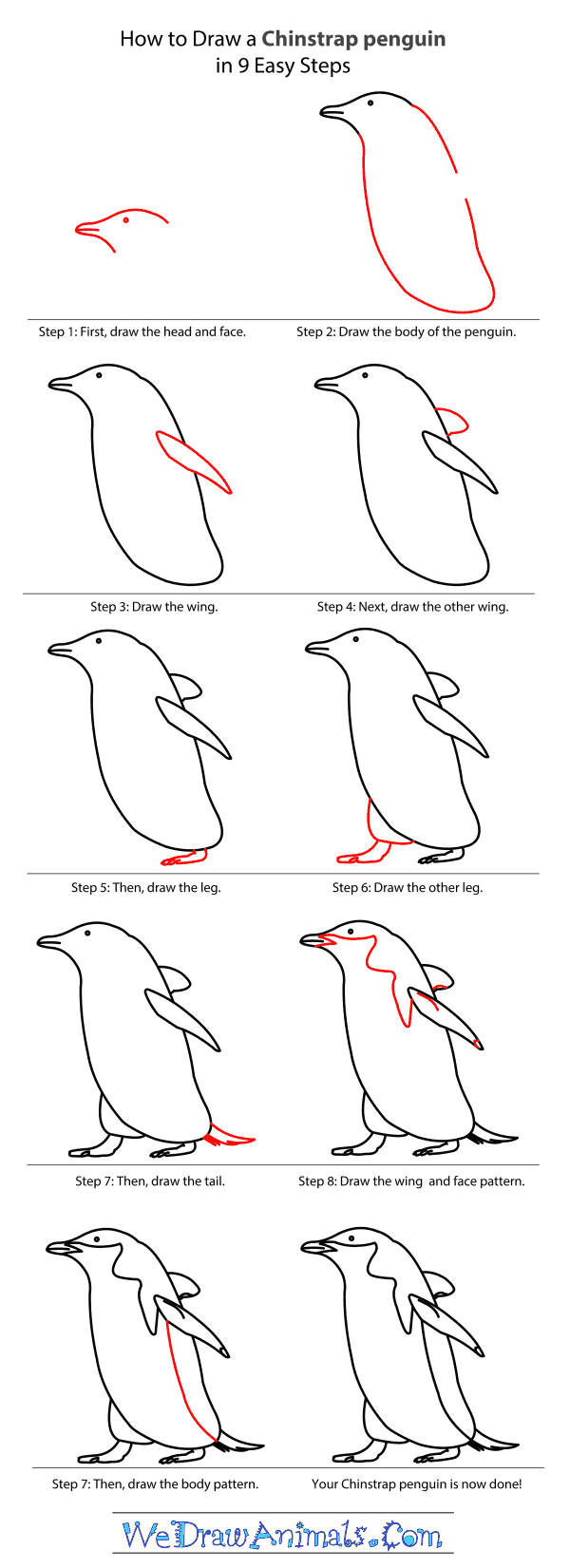In this quick tutorial you'll learn how to draw a Chinstrap Penguin in 9 easy steps - great for kids and novice artists.
The images above represent how your finished drawing is going to look and the steps involved.
Below are the individual steps - you can click on each one for a High Resolution printable PDF version.
At the bottom you can read some interesting facts about the Chinstrap Penguin.
Make sure you also check out any of the hundreds of drawing tutorials grouped by category.
How to Draw a Chinstrap Penguin - Step-by-Step Tutorial
Step 1: First, let us start by drawing the head and pointed beak of the Chinstrap Penguin. Use curved lines to draw the rounded head and the neck. Draw a small line across the beak to separate the upper and lower part of the beak. Draw a circle for the eye.
Step 2: Draw the outline of the Chinstrap Penguin’s body using gently curved lines as shown in the image. Leave a blank space for the penguin’s wing.
Step 3: Draw the outline of the outstretched wing of the penguin using gently curved lines.
Step 4: Next, draw the other wing behind the first one as shown.
Step 5: Draw the leg of the penguin using small L-shaped lines and draw the outline of the foot. Draw the toes with short lines.
Step 6: Now, draw the other leg and foot of the Chinstrap Penguin near the previous one.
Step 7: Draw the outline of the short tail of the penguin and add short curved lines to add the feather details at the end of the tail.
Step 8: Draw the ring pattern on the beak, face and wings of the penguin.
Step 9: Finish the drawing by adding a line to show the markings of the Chinstrap Penguin along the side of the body. Once you complete your drawing, you can start to color in the Chinstrap Penguin.
Interesting Facts about the Chinstrap Penguin (Pygoscelis antarcticus):
The Chinstrap Penguin is a medium-sized penguin weighing 3.2 to 5.3 kilograms and having a length of 66-76 centimeters. They are easy to recognize because of the black line that crosses their white face, their black bill and the way their black eyes are isolated in the white plumage of their face. Chinstrap Penguins live on and around Antarctica and sometimes live on huge icebergs floating around the South Pole. Their favorite food is krill.
Did you know?
- Chinstrap Penguins have an average dive depth of 45 meters of less, but can dive up to 70 meters deep.
- These penguins are able to climb up things, using both feet and both flippers, and can jump relatively large distances, like from one patch of floating sea ice to another.
- One way Chinstrap Penguins cover distance is by lying down on their stomachs and pushing themselves forward across the ice using their feet and flippers. This is called tobogganing, because it looks so much like the human sport of sledding in a toboggan.
- Juvenile Chinstrap Penguins look a lot like the adults, which is different from most other species of penguins.
- At the Central Park Zoo in New York State (U.S.), two male chinstrap Penguins named Roy and Silo formed a couple and successfully hatched an egg that a zookeeper had given them to raise. The juvenile penguin that hatched was named Tango and a children’s book, And Tango Makes Three, by Justin Richardson and Peter Parnell, was written about the story.
The Chinstrap Penguin is not currently in danger of extinction. In fact, its numbers are actually increasing. Some of this may be because of over-hunting of whales that eat krill, which leaves more krill for the Chinstrap Penguins to eat. Efforts are also being made to restrict tourist activity near Chinstrap Penguin breeding colonies.










